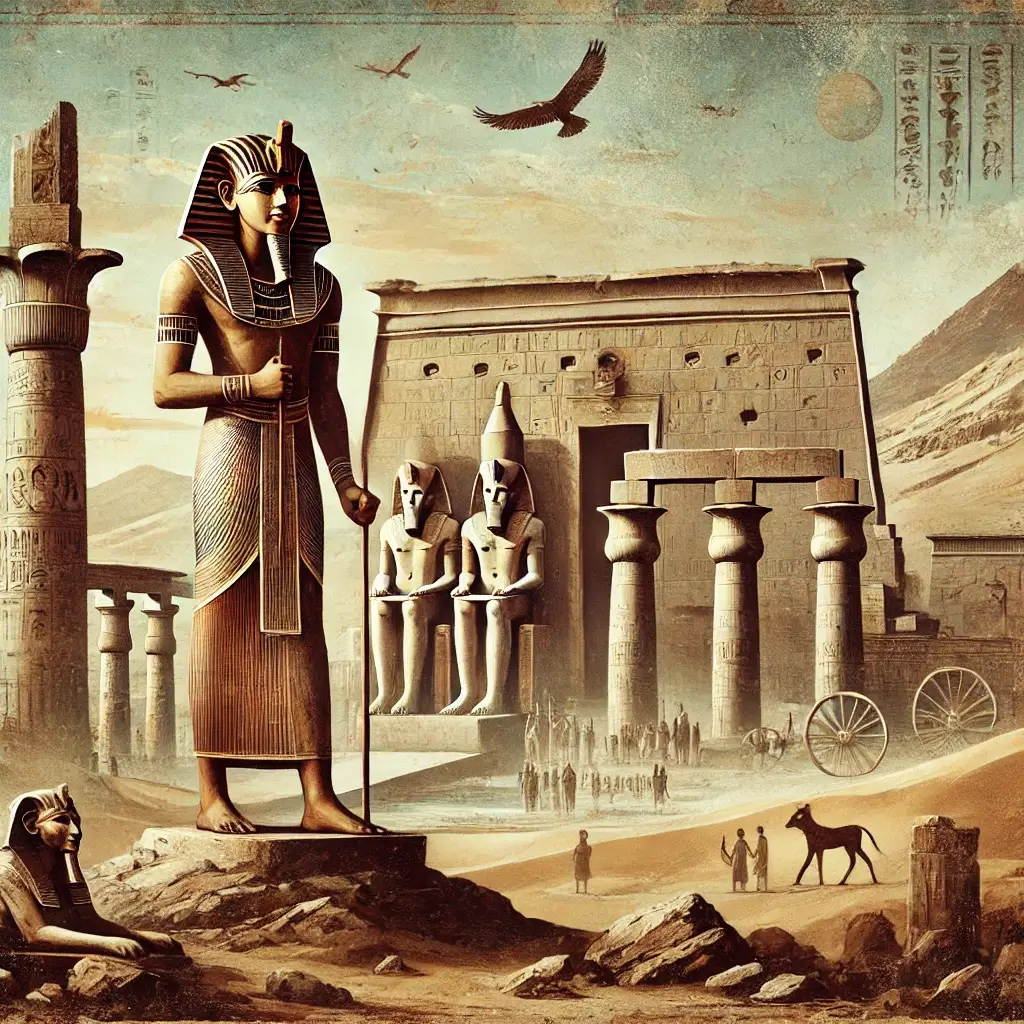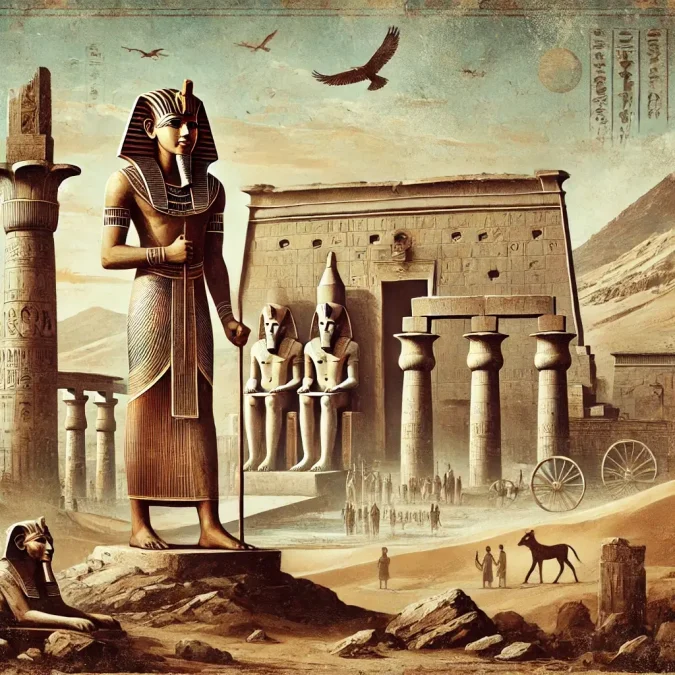
The Twenty-Fourth Dynasty of Egypt (Dynasty XXIV), also known as the 24th Dynasty, is typically classified as the fourth dynasty of the Third Intermediate Period, lasting from approximately 732 BC to 720 BC. The dynasty, although short-lived, played a crucial role in the ongoing power struggle within Egypt during this era. The rulers of the Twenty-Fourth Dynasty were based in the western Delta, specifically in the city of Sais, and their reign represents a period of significant regional division and the assertion of local authority in the face of rival powers.
The Twenty-Fourth Dynasty coexisted with other contemporary dynasties, such as the Twenty-Third and Twenty-Fifth Dynasties, creating a fragmented political landscape that characterized much of the Third Intermediate Period. This article will explore the historical context of the Twenty-Fourth Dynasty, provide an overview of its rulers, and examine the cultural and political developments that occurred during its brief existence.
Historical Background of the Twenty-Fourth Dynasty
The Third Intermediate Period (1077 BC – 664 BC) was a time of political fragmentation and regional rule in Egypt. Following the decline of the New Kingdom, centralized authority weakened, and regional leaders emerged as independent rulers. The Twenty-Fourth Dynasty was one such regional power, with its seat of power located in the city of Sais in the western Delta. The dynasty was founded by Tefnakht, a powerful leader who sought to consolidate power in the Delta and challenge the influence of the contemporaneous Nubian rulers of the Twenty-Fifth Dynasty.
The Twenty-Fourth Dynasty’s rise to power was marked by a series of political maneuvers and military campaigns aimed at expanding its influence over the fragmented regions of Egypt. Tefnakht, the founder of the dynasty, sought to unite the Delta under his rule and resist the expansion of the Nubian rulers who were advancing northward from Kush. Despite his efforts, the Twenty-Fourth Dynasty ultimately faced significant challenges from the Twenty-Fifth Dynasty, which eventually led to its downfall.
The Rulers of the Twenty-Fourth Dynasty
The Twenty-Fourth Dynasty was ruled by two main kings, Tefnakht and Bakenranef. Below, we provide an overview of each ruler and their contributions to the history of this period.
1. Tefnakht (c. 732–726 BC)
Tefnakht was the founder of the Twenty-Fourth Dynasty and the most prominent ruler of this short-lived dynasty. He began his political career as a powerful local leader in the city of Sais, located in the western Delta. Tefnakht was a Libyan chieftain, and like many rulers of the Third Intermediate Period, he sought to establish his authority over the Delta region and challenge the power of rival dynasties.
Tefnakht’s reign was marked by his attempts to consolidate power in the Delta and create a unified front against the advancing Nubian forces led by Piye, the ruler of the Twenty-Fifth Dynasty. Tefnakht formed alliances with other regional rulers in the Delta and Upper Egypt, and together they attempted to resist the Nubian advance. However, Piye’s military campaign ultimately proved successful, and Tefnakht was forced to submit to Nubian authority. Despite this setback, Tefnakht managed to retain some level of autonomy in the Delta, and his efforts to unify the region laid the foundation for the Twenty-Fourth Dynasty.
Tefnakht is also known for his religious devotion and efforts to legitimize his rule through association with traditional Egyptian gods. He supported the construction and renovation of temples in the Delta region, particularly those dedicated to the god Neith, who was the patron deity of Sais. Tefnakht’s reign represents a period of resistance against foreign influence and the assertion of local authority in the face of external threats.
2. Bakenranef (c. 726–720 BC)
Bakenranef, also known as Bocchoris in Greek sources, was the son and successor of Tefnakht. He ruled as the second and last king of the Twenty-Fourth Dynasty. Bakenranef’s reign was relatively brief, but he is remembered for his efforts to maintain the independence of the Delta region in the face of continued Nubian pressure from the south.
Bakenranef is often portrayed in historical records as a wise and just ruler. According to later Greek historians, such as Diodorus Siculus, Bakenranef introduced legal reforms and was known for his fair administration of justice. These reforms were said to have focused on property rights and social justice, which earned him a reputation as a reformer. However, the historical accuracy of these accounts is debated, as much of the information about Bakenranef comes from later sources.
Bakenranef’s reign came to an end when the Nubian king Shabaka, the successor of Piye, launched a campaign to assert control over the Delta. Bakenranef was captured by Shabaka, and according to tradition, he was burned alive as a demonstration of Nubian power. With Bakenranef’s death, the Twenty-Fourth Dynasty came to an end, and the Twenty-Fifth Dynasty established its dominance over all of Egypt, ushering in a new era of Nubian rule.
Political Fragmentation and Regional Rule
The Twenty-Fourth Dynasty was a product of the political fragmentation that characterized the Third Intermediate Period. The weakening of centralized authority following the collapse of the New Kingdom led to the rise of regional rulers who established their own independent dynasties. The rulers of the Twenty-Fourth Dynasty, based in Sais, sought to assert their authority over the Delta region and resist the influence of rival powers, particularly the Nubian rulers of the Twenty-Fifth Dynasty.
The Struggle for Control of the Delta
The rise of the Twenty-Fourth Dynasty was closely tied to the struggle for control of the Delta region. Tefnakht, the founder of the dynasty, sought to unite the various city-states of the Delta under his rule and create a coalition that could resist the advancing Nubian forces. This struggle for control of the Delta was a defining feature of the Third Intermediate Period, as multiple regional rulers vied for power in the absence of a strong centralized government.
Tefnakht’s efforts to consolidate power in the Delta were met with resistance from other local rulers, as well as from the Nubian king Piye, who sought to expand his influence northward. The conflict between Tefnakht and Piye culminated in a military campaign that saw Piye’s forces advance into the Delta and ultimately force Tefnakht to submit. Despite this defeat, Tefnakht managed to retain some level of authority in the Delta, and his dynasty continued under his successor, Bakenranef.
The Influence of the Twenty-Fifth Dynasty
The Twenty-Fourth Dynasty coexisted with the Twenty-Fifth Dynasty, which was founded by the Nubian ruler Piye. The Twenty-Fifth Dynasty, also known as the Nubian or Kushite Dynasty, sought to reunify Egypt and restore centralized authority. Piye’s military campaign against the Delta region brought him into direct conflict with Tefnakht and the Twenty-Fourth Dynasty. Although Tefnakht was forced to submit to Piye, he retained control over Sais and continued to rule as a vassal of the Nubians.
The influence of the Twenty-Fifth Dynasty over the Twenty-Fourth Dynasty became more pronounced during the reign of Bakenranef. Shabaka, the successor of Piye, launched a campaign to assert Nubian control over the Delta and eliminate any remaining resistance. Bakenranef was captured and executed, marking the end of the Twenty-Fourth Dynasty and the beginning of complete Nubian dominance over Egypt. The fall of the Twenty-Fourth Dynasty represents the culmination of the struggle for control of Egypt during the Third Intermediate Period and the establishment of a new era of Nubian rule.
Cultural and Religious Developments
Despite its brief existence, the Twenty-Fourth Dynasty made notable contributions to the cultural and religious life of Egypt. The rulers of the dynasty, particularly Tefnakht, sought to legitimize their rule through religious devotion and the support of traditional Egyptian temples and rituals.
Religious Patronage and Temple Construction
Tefnakht, the founder of the Twenty-Fourth Dynasty, was known for his religious devotion and efforts to associate himself with the traditional gods of Egypt. He supported the construction and renovation of temples in the Delta region, particularly those dedicated to the goddess Neith, who was the patron deity of Sais. By emphasizing his connection to Neith and other traditional deities, Tefnakht sought to legitimize his rule and gain the support of the local population.
The religious patronage of the Twenty-Fourth Dynasty was part of a broader trend during the Third Intermediate Period, in which regional rulers sought to bolster their legitimacy through association with traditional religious practices. The construction and renovation of temples served not only as a demonstration of the ruler’s piety but also as a means of reinforcing their authority in a time of political fragmentation.
The Legacy of Bakenranef
Bakenranef, the second and last ruler of the Twenty-Fourth Dynasty, is remembered for his supposed legal reforms and his reputation as a just ruler. According to later Greek historians, Bakenranef introduced reforms that focused on property rights and social justice. While the historical accuracy of these accounts is uncertain, they suggest that Bakenranef was viewed as a ruler who sought to bring stability and order to a region that had been plagued by political turmoil.
Bakenranef’s legacy is also tied to his tragic end at the hands of Shabaka, the Nubian ruler of the Twenty-Fifth Dynasty. The story of Bakenranef’s execution served as a powerful symbol of the Nubian conquest of Egypt and the end of the Twenty-Fourth Dynasty. Despite his brief reign, Bakenranef’s efforts to maintain the independence of the Delta and his reputation as a reformer left a lasting impression on the history of the Third Intermediate Period.
The Decline of the Twenty-Fourth Dynasty
The decline of the Twenty-Fourth Dynasty was closely linked to the rise of the Twenty-Fifth Dynasty and the expanding influence of the Nubian rulers. The Nubians, led by Piye and later by Shabaka, sought to reunify Egypt and restore centralized authority. Their military campaigns against the Delta region brought them into direct conflict with the Twenty-Fourth Dynasty, which sought to maintain its independence.
The turning point for the Twenty-Fourth Dynasty came during the reign of Bakenranef, who faced a renewed Nubian campaign led by Shabaka. Bakenranef was captured and executed, and the Twenty-Fourth Dynasty came to an end. The fall of the dynasty marked the beginning of complete Nubian control over Egypt, as the Twenty-Fifth Dynasty established its dominance over both Upper and Lower Egypt.
The decline of the Twenty-Fourth Dynasty represents the end of a period of regional rule and political fragmentation in the Delta. Despite their efforts to resist Nubian influence, the rulers of the Twenty-Fourth Dynasty were ultimately unable to withstand the military power of the Twenty-Fifth Dynasty. The fall of the Twenty-Fourth Dynasty paved the way for the reunification of Egypt under Nubian rule and the beginning of a new era in Egyptian history.
Conclusion
The Twenty-Fourth Dynasty of Egypt, founded by Tefnakht and based in the city of Sais, played a significant role in the history of the Third Intermediate Period. Although short-lived, the dynasty’s rulers sought to assert their authority over the Delta region and resist the influence of rival powers, particularly the Nubian rulers of the Twenty-Fifth Dynasty. The reigns of Tefnakht and Bakenranef were marked by political maneuvering, military campaigns, and efforts to legitimize their rule through religious devotion and temple construction.
Despite their efforts, the Twenty-Fourth Dynasty faced significant challenges from the Nubian rulers, who sought to reunify Egypt and restore centralized authority. The fall of the Twenty-Fourth Dynasty marked the end of regional rule in the Delta and the beginning of complete Nubian control over Egypt. The legacy of the Twenty-Fourth Dynasty lies in its resistance to foreign influence and its contributions to the cultural and religious life of the Delta region during a time of political fragmentation.
